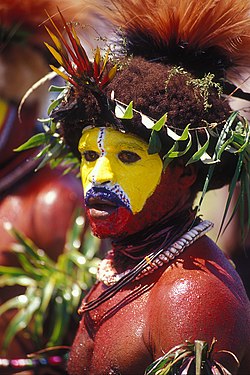Huli language
Engan language spoken in Papua New Guinea From Wikipedia, the free encyclopedia
Huli is a Tari language spoken by the Huli people of the Hela Province of Papua New Guinea. It has a pentadecimal (base-15) numeral system: ngui means 15, ngui ki means 15×2 = 30, and ngui ngui means 15×15 = 225.
| Huli | |
|---|---|
 | |
| Region | Southern Highlands, Papua New Guinea |
| Ethnicity | Huli people |
Native speakers | 150,000 (2011)[1] |
Trans-New Guinea?
| |
| Latin script (Huli alphabet) Huli Braille | |
| Language codes | |
| ISO 639-3 | hui |
| Glottolog | huli1244 |
Huli has a pandanus language called tayenda tu ha illili (bush divide taboo) used for collecting karuka nuts (anga) as well as hunting or traveling.[2] Tayenda is used to evade malevolent bush spirits.[2] The grammar for Tayenda is nearly identical to normal Huli, but the vocabulary is changed, often borrowing words from Duna but with changed meanings.[2]
Phonology
Huli has a syllable structure of (C)V.
Vowels
/ɑ/ is pronounced more fronted as [æ] before /r/ and /ʝ/.[3]
Vowel nasality is phonemic in the language. Vowels can also carry three phonemic tones; high-falling, mid-level, and low-rising.
Consonants
Stops /p t k/ can become aspirated as [pʰ tʰ kʰ].
Many speakers pronounce /t/ as [s] before /i/.
/d/ is realized as voiceless as [d̥] when occurring word-initially, and is palatalized as [dʲ] between /i/ and a word-final /ɑ/.
/r/ only occurs word-medially.
/b ɡ/ can be phonetically realized as fricatives intervocalically as [β ɣ].
References
External links
Wikiwand - on
Seamless Wikipedia browsing. On steroids.
